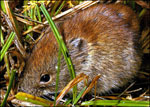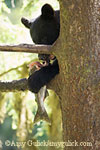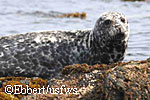Alaska Fish & Wildlife News
November 2008
Voles in Alaska
Small but Mighty Important

Voles are among the smallest mammals – adults weigh less than four ounces – yet they play a huge role in the food chain. They are the primary food source for many small mammals and birds in Alaska, including weasels, martens, foxes, coyotes, owls, hawks and jaegers.
Even bears and wolves will eat voles, with black bears sometimes turning over logs and breaking into brush to find them.
“Anything predatory will take them opportunistically,” said Ian Van Tets, an assistant professor of ...
Voles in Alaska ArticleContinued
Why Fish Need Trees and Trees Need Fish

Albert Einstein once said, “If you judge a fish by its ability to climb a tree, it will live its whole life believing that it is stupid.” This article isn't about the self esteem of fish, but how salmon, or at least parts of them, actually do “climb” trees. As research continues to show, trees depend on salmon, and salmon depend on trees. And in the process, countless plants and animals benefit from the incredible nutrient exchange inherent in every part of the process.
Salmon are anadromous ...
Trees Need Fish ArticleContinued
Harbor Seals in Trouble
Some Areas Have Seen Dramatic Declines

Many of Alaska's marine mammals have been in trouble in recent years. Recent declines of Steller sea lions, northern sea otters and northern fur seals are well documented in the Bering Sea and Aleutian Islands.
But how are harbor seals faring?
Biologists and others in the region suspected harbor seals had also declined in the Aleutians, but until recently, no one had the data to prove it.
Bob Small, Fish and Game's statewide marine mammal program coordinator, said ...
Seals in Trouble ArticleContinued
Alaska’s Stately Sandhill Cranes

With the advent of autumn, V-shaped squadrons of migrating birds cut through the sky as they head south. Among the most impressive of these fall migrants are sandhill cranes, their distinct rattling call and six-foot-wingspans setting them apart from ducks and geese.
Cranes are superficially similar to our familiar great blue herons – both are long-necked, stately wading birds with pointed bills – but they are not otherwise related. Unlike herons, cranes come together in great flocks for ...
Sandhill Cranes ArticleContinued
